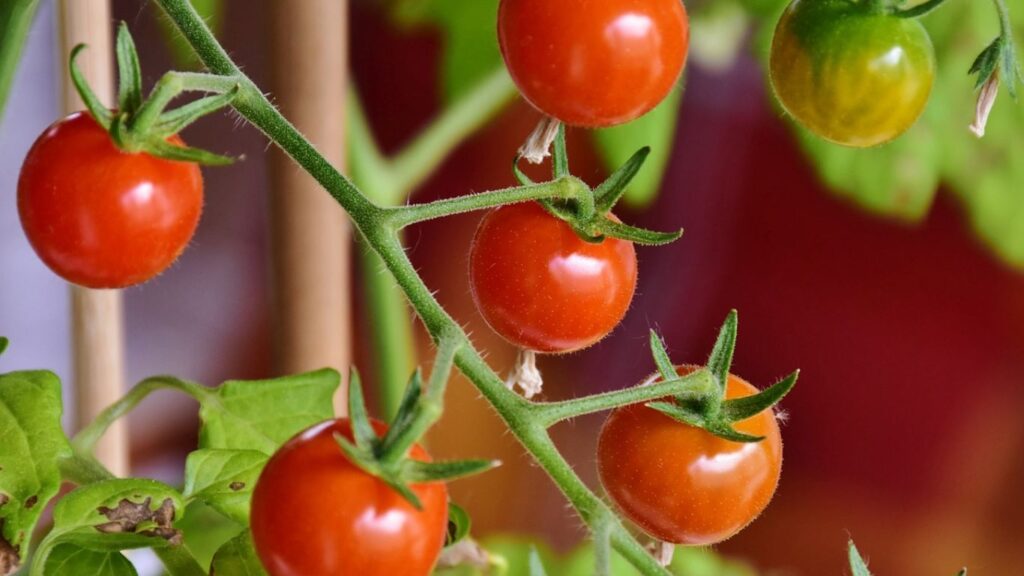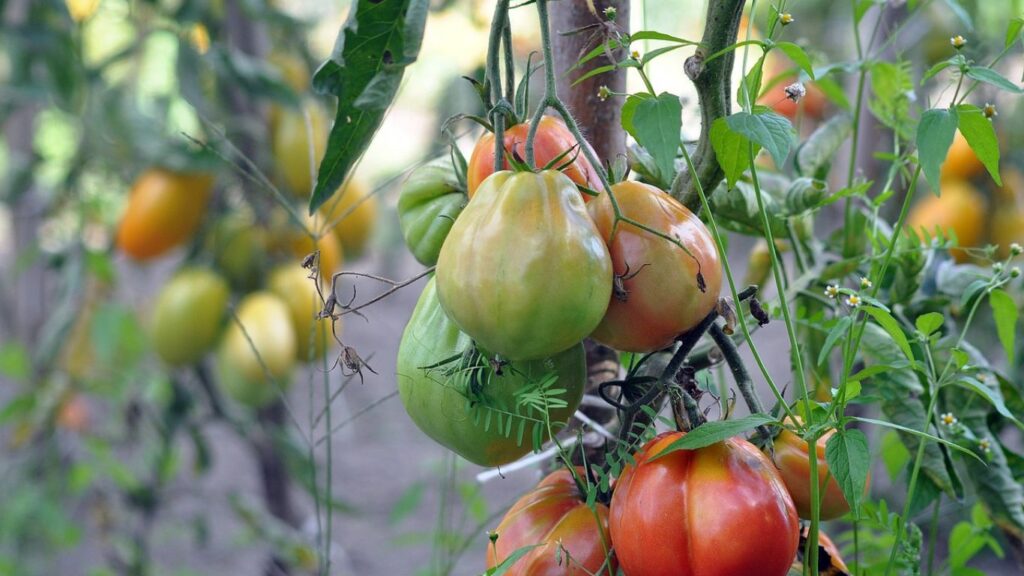Are you worried about tomato plants brown leaves? Pay attention to this article to know the best remedy to ensure the solution.
Growing tomatoes is easy and rewarding for beginners as well as seasoned gardeners as you can enjoy the fruits of your hard work in the form of fresh and organic tomatoes.
There are so many variations with distinct colors, textures, and flavors that you can try every year without getting bored.
Tomato plants are notorious for their problems. As fast-growing as they are, and as tasty as they can be, growing them can be a challenge.
However, it is so unfortunate that the tomato is not immune to infectious diseases.
As summer kicks into full swing and tomato season gets into full swing, a common problem we see in our gardens is browning of tomato leaves.
This can come in the form of spots, wilting, shriveling, or even falling leaves.
Many gardeners become alarmed when some leaves on their tomato plants begin to turn brown and in some cases even die and fall off.
This can be especially true for lower leaves on tomato plants in mid to late summer.
Often, when a plant has a problem it will first appear on the lowest leaves. And if the problem is serious enough it spreads to the rest of the plant.
You might be seeing tomato leaves turning brown and wondering about the reason behind it.
There could be multiple reasons behind this and in this article, we have discussed it in detail to help you identify the reason.
We have discussed the causes of browning of tomato leaves.
So, in this article, I will share with you the common reasons why tomato leaves are turning brown.
Here’s how to keep your plants healthy and productive, including what to do for leaf spot, wilt and other problems.
I will give some suggestions for each problem on how to properly prevent the problem or move forward. Let’s get started.
Why is My Tomato Plants Leaves Turning Brown?

So what is the reason for this? Could it be the lack of water or nutrients? Could the dreaded tomato blight or other tomato disease start?
The truth is, there can be many reasons why tomato plant leaves begin to fail or fade in midsummer.
As you’ll see below, late season blight is definitely a major culprit for late season tomato plant failure.
And in other cases the death of plants is completely natural.
So before you even start thinking your tomato crop could be in dire jeopardy!
Why Are My Tomato Leaves Turning Brown and Dropping?

Determinate Versus Indeterminate Tomatoes:
In some cases, the cause of tomato plants turning yellow and dying can be 100 percent normal.
Why would a tomato plant suddenly start dying in the middle of summer? Because it could be a decisive tomato!
Tomato is either determinate, or indeterminate. Indeterminate tomatoes will grow and produce until a frost or freeze occurs.
But certain tomato varieties have a specific lifespan. They produce their entire crop within three to four weeks and then die quickly.
A great example is the Roma tomato. The Roma tomato is quite popular among home gardeners.
But Roma tomatoes are the definitive plant. So after their main crops are ripe, they will die whatever.
Unfortunately, this plant is often mistaken as a late-season problem by gardeners every year when in reality, it’s simply run its course.
So before you think your plant might be in trouble, check to see if it might just be a specific variety.
If your plant isn’t a specific one and the leaves are starting to turn yellow or brown then it’s probably one of the following problems:
Tomato Plants Brown Leaves For Nutritional Deficiency

One of the biggest causes of tomato plant damage in summer is nutrient deficiency. The tomato plant is a heavy feeder.
And when they do, leaves and plants can suffer. Summer fertilization is essential to keeping your plants strong, healthy and productive.
Fertilize your plants every two weeks with a liquid fertilizer that is higher in phosphorus and potassium than nitrogen.
This will help it continue to produce flowers and fruit, and not just turn green.
Tomato Plants Brown Leaves For Lack of Water

Too much or too little water is another major cause of tomato plant damage in midsummer.
If it doesn’t fall from the sky, watering is essential to keep the foliage strong and the plant productive.
More than anything else, watering the plants during extended dry periods
keep going When watering, water deeply and not for a few minutes on the surface.
This will help plant roots to grow deeper, preventing them from drying out easily.
Avoid Fruit Overload In some cases, your plant is suffering from fruit overload.
If you allow too many tomatoes on one plant at once, it will stop the plant producing.
This is called fruit overload and it is common in many vegetable plants, not just tomato plants.
Tomato plants should be cut often during the growing season. It will maintain the plant’s energy in growing and producing.
And do not worry if these tomatoes are not fully ripe. Tomato blight is a spore disease that infects the soil and the plants.
Although dead, brown leaves are a symptom, the real symptom of tomato blight is the appearance of greasy, oily spots on your tomatoes.
When you see this, it’s definitely time to pull plants.
Tomato blight is highly contagious, and controlling it as soon as possible is critical.
Do not compost plants, but burn or throw them away. In addition, locate next year’s plants as far away from the site as possible.
But taking good care of your crop means keeping an eye out for tomato plant diseases caused by fungi, bacteria and viruses, which can cause leaf spot and blight.
Temperature, nutrient levels, and humidity levels can also cause problems, potentially ruining your crop.
You can avoid these potential problems by familiarizing yourself with their symptoms and using a few simple strategies.
With a little effort, your plants can stay healthy and productive throughout the season.
How To Control Diseases of Tomato Plant

Choosing disease resistant varieties, proper spacing between tomato plants.
Using mulch and watering at least 1 inch per week are some of the most important steps to keep your tomato plants disease free.
Many common plant diseases and pests hide in the soil.
Which is why it’s a good idea to rotate where you plant your tomatoes so that they don’t grow in the same soil any time during the four years.
Wet leaves can also spread disease, so avoid crowding your tomatoes too close together. This helps in better air circulation and leaves dry faster.
When watering, focus on the base of your tomato plants so that water splashes on the leaves in the morning and less so that wet leaves have time to dry before the cool evening temperatures arrive.
Even when following all these good growing practices, there is a chance that some tomato plant diseases will appear.
For those caused by fungi, bacteria, and viruses, your plants are almost impossible to cure once they become infected.
However, if you catch the problem early, you can try to slow the spread by removing and destroying leaves or entire plants that are showing symptoms.
You can try to prevent diseases from taking hold by regularly treating with a product labeled to control the disease.
Tomato Plants Brown Leaves For Diseases & Problems
Tomatoes are generally strong growers that will reward you with a bumper crop if grown in full sun with plenty of water and nutrients.
Septoria Leaf Spot

A fungus causes Septoria leaf spot, small, round patches with a gray white center and dark edges.
Small black spots may appear in the center of each spot. Infected leaves turn yellow, dry and at last fall off.
Prolonged warm, humid weather favors the development of this tomato plant disease, and splashing water quickly spreads spores to other leaves.
Tomato Plants Brown Leaves For Anthracite
This fungus is a small, circular, indented area on the tomato fruit. Finally, rings surround the original space.
The flesh of the fruit can rot completely, especially on overripe tomatoes, so pick the fruit as soon as it is ripe.
Spash is spread through water and the fungus is more common in warm, humid weather.
Fusarium and Verticillium Wilt
These wilted tomato plant diseases are caused by fungi in the soil that enter through the young roots and then begin to plug the water moving vessels in the roots and stems of the plant.
Without enough water, the plants begin to wither on sunny days, although they will seem to recover at night.
Wilting of tomatoes may occur first on the upper or lower leaves of the plant, causing them to lose color and then die from the tips.
The process continues till the whole plant is affected.
To help control these tomato plant diseases, tomato plants are bred for resistance. The soil long enough to infect a new host.
Tomato Plants Brown Leaves For Early Blight
Another tomato disease fungus, Alternaria, causes early blight. The lower leaves show brown or black spots with dark edges, almost like the target.
The stem ends of the fruit may be attacked, showing large, sunken black spots with concentric rings. This fungus usually attacks plants after fruiting.
Tomato Plants Brown Leaves For Late Blight
Rapidly spreading tomato plant disease is caused by the fungus Phytophthora infestans and occurs during cool, rainy weather that may come at the end of a growing season.
It looks almost like frost on the leaves, causing irregular green-black spots. Fruits may have large, irregularly shaped brown spots that rot quickly.
This plant disease also affects potatoes and can be transferred from them.
Tomato Plants Brown Leaves For Mosaic Virus

infects many types of plants and is a common disease of tomato plants.
Although mosaic virus does not kill the plant, it does reduce the number and quality of fruit.
A light green and yellow mosaic on the leaves and spots on the fruit of the affected plants can be seen, the fern-like leaves may grow into an invisible form.
Conclusion
Improve your tomato harvest with these tips For best and most abundant tomato crops, pruning is preferred.
Once you’ve discovered whether your tomato plants are a determinate or indeterminate variety.
You can learn how to proceed with suction, leaf, fruit thinning, and keeping your plants as clean as possible.
Knowing the best time to harvest your tomatoes will make the tastiest additions to salads, sauces and sandwiches.
Prevent pests from eating your carefully cultivated crops, and you’ll have more tomatoes than you know what to do with.
Reference:
